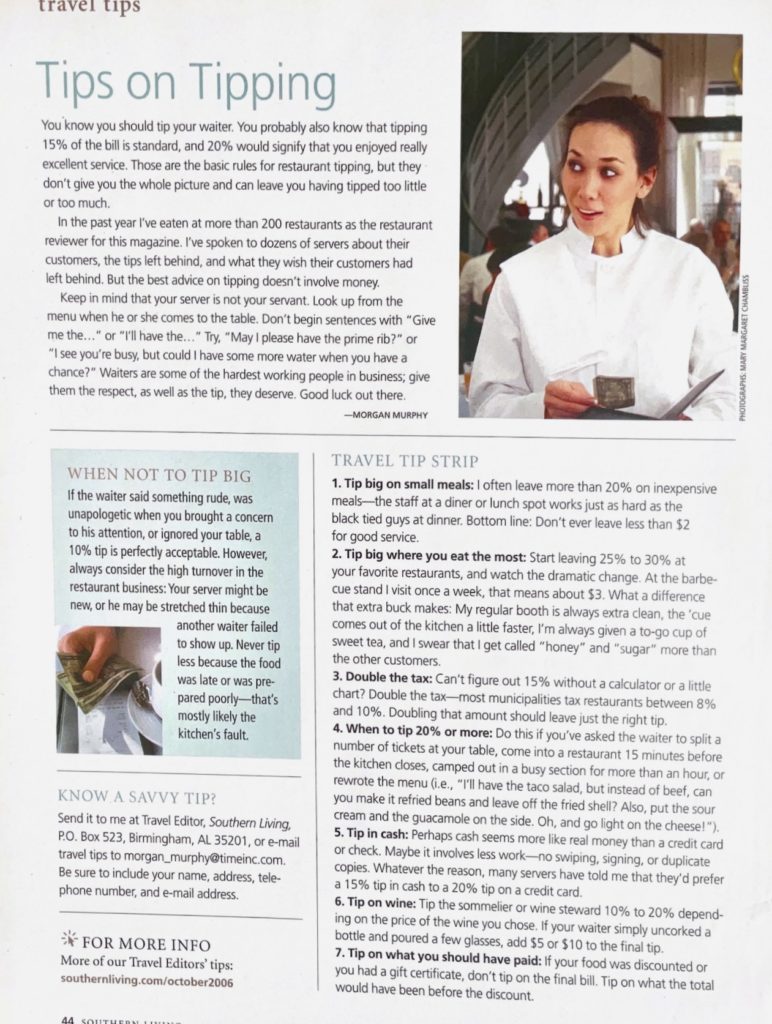As published in Southern Living
Editor’s Tip You know you should tip your waiter. You probably also know that tipping 15% of the bill is standard, 20% would signify that you enjoyed really excellent service. Those are the basic rules for restaurant tipping, but they don’t give you the whole picture and can leave you having tipped too little or too much.
In the past year I’ve eaten at over 200 restaurants as the restaurant reviewer for this magazine. I’ve spoken to dozens of servers about their customers, the tips left behind, and what they wish their customers had left behind.
The best tip on tipping doesn’t involve money. Your server is not your servant. Look up from the menu when they come to the table. Don’t begin sentences with “Give me the . . .” or “I’ll have the . . .” Try, “May I please have the prime rib?” or “I see you’re busy, but could I have some more water when you have a chance?” Waiters are some of the hardest working people in business—give them the respect, as well as the tip, they deserve. Good luck out there. –Morgan Murphy
When Not To Tip Big
If the waiter said something rude, was unapologetic when you brought a concern to his attention, or simply ignored your table, a 10% tip is perfectly acceptable. Use this rule with caution, however. Always consider the high turnover in the restaurant business: Your server might be new or he or she may be stretched thin because another waiter failed to show up for the shift. And never tip less because the food was late or was prepared poorly—that’s mostly likely the kitchen’s fault.
Travel Tip Strip
1. Tip Big on Small Meals I often leave over 20% on inexpensive meals—the staff at a diner or lunch spot works just as hard as the black-tied guys at dinner. Bottom line: Don’t ever leave less than $2 for good service.
2. Tip Big where You Eat the Most Start leaving 25% to 30% at your favorite restaurants and watch the dramatic change. At the barbecue stand I visit once a week, that means about $3. What a difference that extra buck makes: My regular booth is always extra clean, the ‘cue comes out of the kitchen a little faster, I’m always given a to-go cup of sweet tea, and I swear that I get called “honey” and “sugar” more than the other customers.
3. Double the Tax Can’t figure out 15% without a calculator or a little chart? Double the tax—most municipalities tax restaurants between 8% and 10%. Doubling that amount should leave the wait staff just the right tip.
5. Tip 20% or More if . . . you’ve asked the waiter to split a number of tickets at your table; if you come into a restaurant 15 minutes before the kitchen closes; if you’ve “camped out” in a busy section for over an hour; or if you rewritten the menu i.e., “I’ll have the taco salad, but instead of beef, can you make it refried beans and leave off the fried shell? Also, put the guacamole and the sour cream on the side. Oh, and go light on the cheese!”
6. Tip in Cash Perhaps cash seems more like real money than a credit card or check. Maybe it involves less work—no swiping, signing, or duplicate copies. Whatever the reason, many servers have told me that they’d prefer a 15% tip in cash to a 20% tip on a credit card.
7. Tip on Wine If a sommelier or wine steward helped you with your selection, tip 10% to 20% depending on the price of the wine you chose. If your waiter simply uncorked a bottle and poured a few glasses, adding $5 or $10 to the final tip is appropriate.
8. Tip on What You Should Have Paid If your food was discounted or you had a gift certificate, don’t tip on the final bill. Tip on what the total would have been before the discount.

